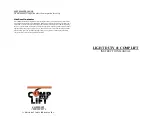
Fundamental Safety Instructions
10 / 41
5270.0015 / 5270.0016 / 5270.0017 / 5270.0018
2 Fundamental Safety Instructions
2.1 Intended Use
The lifting device SPEEDY VS-140/200 is used to lift, transport and set down porous sheets and exposed-aggregate con-
crete surfaces and similar objects close to the floor.
•
The standard version of the lifting device is manually operated by two operators. Maximum permitted load 140 kg.
•
Using the optionally available suspension eye, the lifting device can also be attached to a suitable transport device
(crane, construction vehicle, etc.). Only handle loads with a load securing chain. Maximum permitted load 200 kg.
The control handles are permitted only for a maximum lift capacity of 140 kg.
The loads to be lifted must be rigid enough to ensure they are not destroyed during lifting.
The suction plate is not included in delivery. The user must ensure that only suction plates suitable for the load to be
lifted are used. It must be designed to be mounted to the lifting device.
The maximum lift capacity must not be exceeded (> See ch. Technical data). The maximum permitted load depends on
the suction plate used (see the lift capacity plate on the suction plate).
The lifting device is built in accordance with the latest standards of technology and is delivered in a safe operating condi-
tion; however, hazards may arise during use.
2.2 Non-Intended Use
Probst accepts no liability for damage caused by the use of the lifting device for purposes other than those described
under Intended Use. The use of the lifting device for loads that are not specified in the order confirmation or that have
different physical properties than those specified in the order confirmation shall be considered non-intended use. In par-
ticular, the following are considered non-intended use:
•
Use as a climbing aid.
•
Lifting people or animals.
•
Storing loads while picked up.
•
Picking up building components, equipment or supporting surfaces.
•
Picking up liquids or bulk materials (e.g. granulate).
•
Evacuating objects that are in danger of imploding.
•
Attachment of loads using ropes, chains or similar
2.3 Danger Zone
2.3.1 Manual Handling
The lifting device is operated by two operators. The operators stand between the operator handles.
The area under the suction plates must be considered a danger zone.
2.3.2 Handling with a Transport Device
Persons in the danger zone of the lifting device may suffer life-threatening injuries.
•
Ensure that no unauthorized persons are present in the danger zone.
•
Ensure that collisions with the surrounding environment and objects are avoided to prevent the load from breaking
off.
The danger zone of the lifting device includes the following areas:
•
The area directly below the lifting device and load.
•
The area immediately surrounding the lifting device and load.
•
The working area of the transport device used.
Summary of Contents for SPEEDY VS-140/200
Page 3: ......
Page 4: ......
Page 45: ...41 41 5270 0015 5270 0016 5270 0017 5270 0018...
Page 48: ......
Page 88: ...5270 0015 5270 0016 5270 0017 5270 0018 40 41...
Page 89: ...5270 0015 5270 0016 5270 0017 5270 0018 41 41...
















































